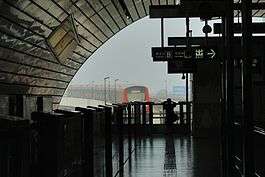Fangshan Line, Beijing Subway
| Fangshan Line, Beijing Subway | |||||||||||||||||||||||||||||||||||||||||||||||||||||||||||||||||||||||||||||||||||
|---|---|---|---|---|---|---|---|---|---|---|---|---|---|---|---|---|---|---|---|---|---|---|---|---|---|---|---|---|---|---|---|---|---|---|---|---|---|---|---|---|---|---|---|---|---|---|---|---|---|---|---|---|---|---|---|---|---|---|---|---|---|---|---|---|---|---|---|---|---|---|---|---|---|---|---|---|---|---|---|---|---|---|---|
|
| |||||||||||||||||||||||||||||||||||||||||||||||||||||||||||||||||||||||||||||||||||
|
Fangshan Line train entering Changyang Station. | |||||||||||||||||||||||||||||||||||||||||||||||||||||||||||||||||||||||||||||||||||
| Overview | |||||||||||||||||||||||||||||||||||||||||||||||||||||||||||||||||||||||||||||||||||
| Type | Rapid transit | ||||||||||||||||||||||||||||||||||||||||||||||||||||||||||||||||||||||||||||||||||
| System | Beijing Subway | ||||||||||||||||||||||||||||||||||||||||||||||||||||||||||||||||||||||||||||||||||
| Status | Operational | ||||||||||||||||||||||||||||||||||||||||||||||||||||||||||||||||||||||||||||||||||
| Termini |
Suzhuang Guogongzhuang | ||||||||||||||||||||||||||||||||||||||||||||||||||||||||||||||||||||||||||||||||||
| Stations | 11 | ||||||||||||||||||||||||||||||||||||||||||||||||||||||||||||||||||||||||||||||||||
| Daily ridership |
102,600 (2014 Avg.) 132,100 (2014 Peak)[1] | ||||||||||||||||||||||||||||||||||||||||||||||||||||||||||||||||||||||||||||||||||
| Operation | |||||||||||||||||||||||||||||||||||||||||||||||||||||||||||||||||||||||||||||||||||
| Operator(s) | Beijing Mass Transit Railway Operation Corp., Ltd | ||||||||||||||||||||||||||||||||||||||||||||||||||||||||||||||||||||||||||||||||||
| Technical | |||||||||||||||||||||||||||||||||||||||||||||||||||||||||||||||||||||||||||||||||||
| Line length | 24.79 km (15.40 mi) | ||||||||||||||||||||||||||||||||||||||||||||||||||||||||||||||||||||||||||||||||||
| Track gauge | 1,435 mm (4 ft 8 1⁄2 in) | ||||||||||||||||||||||||||||||||||||||||||||||||||||||||||||||||||||||||||||||||||
| |||||||||||||||||||||||||||||||||||||||||||||||||||||||||||||||||||||||||||||||||||
The Fangshan Line of the Beijing Subway (Chinese: 北京地铁房山线; pinyin: běijīng dìtiě fángshān xiàn) is a subway line in western Beijing that runs from Suzhuang in Fangshan District north and east to Guogongzhuang in Fengtai District. The line is 24.79 km (15.40 mi) long, has 11 stations (9 surface; 2 underground) and opened on December 31, 2010. The line is mainly elevated, same as the reverse point at Suzhuang. By function, it is very similar to commuter rail as it starts from a Line 9 terminal (Guogongzhuang Station). So, if you were to travel to Suzhuang from West Railway Station: you will take Line 9 to Guogongzhuang Station and transfer at Guogongzhuang Station to Fangshan Line.
As of March 15, 2014, the Fangshan Line connects with only one other subway line, Line 9 at Guogongzhuang. The line will be extended further north to the southwest corner of the Third Ring Road, and will connect with Line 10 at Shoujingmao (Capital University of Economics) and with Line 16 at Fengyiqiao South. The southern terminus at Suzhuang will serve as the northern terminus for the Yanfang Line.
Route
The Suzhou Dajie station is located at the intersection of Changhong Xi Lu and Suzhuang Dajie in the Liangxiang section of Fangshan. The line makes four stops in Liangxiang including at the Fangshan Campus of the Beijing Institute of Technology. The line then heads north to the towns of Guangyang and Changyang. After crossing the Yongding River, the Fangshan Line enters Fengtai District where the line makes its two most northern stops, at Dabaotai near the Beijing World Park, and at Guogongzhuang, also the southern terminus of Line 9.
From Guogongzhuang, where the line currently terminates, the Fangshan Line will be extended further to the northeast for 4.6 km to the southwest corner of the Third Ring Road.[2] The line will have four additional stations—Fanyang Lu (樊羊路), Huaxiangqiao East (花乡桥东), Shoujingmao (Capital University of Economics) and Fengyiqiao South (丰益桥南), and will connect with Line 10 at Shoujingmao and with Line 16 at Fengyiqiao South.[2] The Fangshan Line's current southern terminus, Suzhuang will serve as the northern terminus for the Yanfang Line.
Stations
Stations from the northeast to the southwest:[3]
| English |
Hanzi |
|
|
|
| Fengyiqiao South | 丰益桥南 | 16 | Fengtai | |
| Shoujingmao | 首经贸 | 10 | 67 | |
| Huaxiangqiao East | 花乡桥东 | |||
| Fanyanglu | 樊羊路 | |||
| Guogongzhuang | 郭公庄 | 9 | 470 | |
| Dabaotai | 大葆台 | 480 840 912 967 969 | ||
| Daotian | 稻田 | 391 | Fangshan | |
| Changyang | 长阳 | 646 832 956 993 专93 专94 | ||
| Libafang | 篱笆房 | 646 907 951 993 | ||
| Guangyangcheng | 广阳城 | 956 | ||
| Liangxiang University Town North | 良乡大学城北 | |||
| Liangxiang University Town | 良乡大学城 | 896 | ||
| Liangxiang University Town West | 良乡大学城西 | 895 | ||
| Liangxiangnanguan | 良乡南关 | 833 835 895 897 956 | ||
| Suzhuang | 苏庄 | 833 897 907 971 993 | ||
History
Construction of the Fangshan Line was originally set to begin in 2012[4] but was moved up to April 1, 2009 to use stimulus funding provided by the government to counter the Financial Crisis of 2007-08.[3] On April 1, 2009 eleven station names were initially unveiled,[3] but most of the stations were subsequently renamed on March 23, 2010.[5]
On December 30, 2010, the line began operating from Suzhuang to Dabaotai, but was not connected to any other line of the subway system. One year later, on December 31, 2011, the Dabaotai to the Guogongzhuang section opened, linking the Fangshan Line with Line 9 and the rest of the subway network.
References
| Wikimedia Commons has media related to Fangshan Line, Beijing Subway. |
- ↑ "2014年4月30日综合交通总体运行情况". 北京市交通信息中心 北京市交通运行监测调度中心. 2014-05-01. Retrieved 2014-05-02.
- 1 2 (Chinese) 梁琦, "房山线北延 衔接16号线" 北青网-北京青年报 2014-03-01
- 1 2 3 "地铁房山线11座站名确定" 京华时报 Jan. 7, 2009 (Chinese)
- ↑ "北京轨道交通房山线提前至年内开工", 北京晨报 June 29, 2008 (Chinese)
- ↑ 北京地铁房山线规划方案公布 设车站11座 Mar. 24, 2010 (Chinese)
